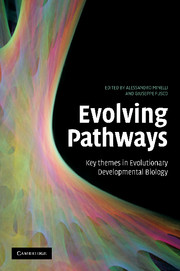Book contents
- Frontmatter
- Contents
- Contributors
- Preface
- Introduction: Pathways of change
- Part I Thinking about evolution by taking development on board
- 1 Evo-devo as a discipline
- 2 Making evolutionary predictions about the structure of development and morphology: beyond the neo-Darwinian and constraints paradigms
- 3 Conflicting hypotheses on the nature of mega-evolution
- 4 Prospects of evo-devo for linking pattern and process in the evolution of morphospace
- 5 The molecular biology underlying developmental evolution
- 6 Evo-devo's identity: from model organisms to developmental types
- Part II Evo-devo: methods and materials
- Part III Evolving diversity
- Part IV Evolving body features
- Index
- References
3 - Conflicting hypotheses on the nature of mega-evolution
Published online by Cambridge University Press: 08 August 2009
- Frontmatter
- Contents
- Contributors
- Preface
- Introduction: Pathways of change
- Part I Thinking about evolution by taking development on board
- 1 Evo-devo as a discipline
- 2 Making evolutionary predictions about the structure of development and morphology: beyond the neo-Darwinian and constraints paradigms
- 3 Conflicting hypotheses on the nature of mega-evolution
- 4 Prospects of evo-devo for linking pattern and process in the evolution of morphospace
- 5 The molecular biology underlying developmental evolution
- 6 Evo-devo's identity: from model organisms to developmental types
- Part II Evo-devo: methods and materials
- Part III Evolving diversity
- Part IV Evolving body features
- Index
- References
Summary
Here is a question of the utmost importance for our understanding of what has been called the ‘big picture’ of evolution (Simpson 1944, 1953): are the divergences that lead ultimately to high-level sister groups, such as those that would typically be labelled as orders, classes and phyla, qualitatively or quantitatively different from those that lead to low-level sister groups, such as races, species and genera? In other words, is mega-evolution more than just accumulated micro/macro-evolution, or alternatively is evolution effectively ‘scale-independent’ (Leroi 2000)?
This question can be approached in three ways. We can choose to compare the magnitude of changes involved in high- and low-level divergences, the type of changes, or the timing (in development) of changes. Here, I argue that previous work on the first of these has been unproductive and has generated more heat than light; but that the second and third offer better prospects for shedding light on this important issue. However, in an unusual strategy, I also play devil's advocate with my own argument at the end of the chapter. This helps to take us in an interesting, final (for now) direction.
Because the designation of high-level sister groups as, for example, orders or classes, is a subjective rather than an objective process, I will, wherever possible, use specific examples rather than general levels of taxon.
- Type
- Chapter
- Information
- Evolving PathwaysKey Themes in Evolutionary Developmental Biology, pp. 50 - 61Publisher: Cambridge University PressPrint publication year: 2008



